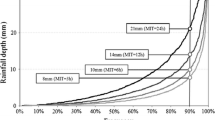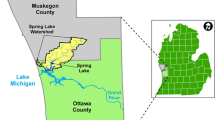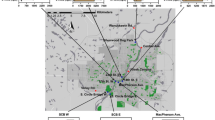Abstract
Stormwater runoff at airports is a significant and costly issue, especially for the stormwater laden with deicing contaminants of high Biochemical Oxygen Demand (BOD) and aquatic toxicity. To reduce the loading of deicing constituents in stormwater and to manage the increasing pressure of tightening regulations, identifying fate and transport and evaluating environmental risks of deicing stormwater are of critical importance. In this review, the regulatory development of airport deicing stormwater management was first discussed, along with the milestone Airport Cooperative Research Program (ACRP) Report 14 publication. The deicer usage and fugitive losses can be reduced and the amount of deicer collected can be increased by having a better understanding of the fate and transport of deicing constituents in stormwater. As such, an overview and evaluation of the constituents of concern in deicers were provided to support the assessment of environmental impacts and mitigation recommendations. The state of knowledge of airport deicing stormwater management was then reviewed, which needs to be synthesized into a national guidance document. A guidebook and a decision tool for airports were proposed to adopt specific practical stormwater management strategies while balancing their priorities in environmental, economic, and social values against operational constraints. These challenges pose great opportunities to improve the current practices of airport deicing stormwater management.
Similar content being viewed by others
References
ACRP 02–61. On-Going Project: Airport Stormwater Management Electronic Resource Library and Training Materials, 2016
Report A C R P. 14. Airport Cooperative Research Program, United States. Federal Aviation Administration, CH2M HILL (Firm), CH2M Hill, Inc, Gresham, Smith, & Barnes & Thornburg. Deicing Planning Guidelines and Practices for Stormwater Management Systems. Transportation Research Board, Washington, DC, 2009
EPA. Effluent Guidelines, Airport Deicing Effluent Guidelines. Last updated January 28, 2016 (http://www.epa.gov/eg/airport-deicingeffluent-guidelines)
EPA. Effluent Guidelines for Airport Deicing Discharges, Presentation at the Airports Council International and Airlines for America’s Deicing Management Conference, Washington, DC, May 23, 2012
EPA. Fact Sheet, Effluent Guidelines for Airport Deicing Discharges. U.S. Environmental Protection Agency, Washington, DC, 2012
McCarthy J E C. Copeland. EPA Regulations: Too Much, Too Little, or On Track?’ 2011
Gray L. Review of Aircraft Deicing and Anti-Icing Fluid Storm Water Runoff Control Technologies, Rensselaer Polytechnic Znstitute, 2013
EASA. Regulation of Ground deicing and Anti-icing Services in the EASA Member States, European Aviation Safety Agency, EASA.2009/4, 2011
Shi X. Impact of Airport Pavement Deicing Products on Aircraft and Airfield Infrastructure. ACRP Synthesis 6. Washington, DC: National Academies Press, 2008
Switzenbaum M S, Veltman S, Mericas D, Wagoner B, Schoenberg T. Best management practices for airport deicing stormwater. Chemosphere, 2001, 43(8): 1051–1062
Astebol S O, Hvitved-Jacobsen T, Simonsen Ø. Sustainable stormwater management at Fornebu-from an airport to an industrial and residential area of the City of Oslo, Norway. Science of the Total Environment, 2004, 334–335: 239–249
Smith Reynolds Airport. Stormwater pollution prevention plan. Winston Salem, North Carolina. Report No. NCG 150000, December, 2010
Ingvertsen S T, Jensen M B, Magid J. A minimum data set of water quality parameters to assess and compare treatment efficiency of stormwater facilities. Journal of Environmental Quality, 2011, 40 (5): 1488–1502
Freeman A I, Surridge B W J, Matthews M, Stewart M, Haygarth P M. Understanding and managing deicer contamination of airport surface waters: A synthesis and future perspectives. Environ. Technol Innov, 2015, 3: 46–62
Sulej A M, Polkowska Z, Namiesnik J. Pollutants in Airport Runoff Waters. Critical Reviews in Environmental Science and Technology, 2012, 42(16): 1691–1734
Ferguson L, Corsi S R, Geis SW, Anderson G, Joback K, Gold H, Mericas D, Cancilla D A. Formulations for Aircraft and Airfield Deicing and Anti-Icing: Aquatic Toxicity and Biochemical Oxygen Demand. University of South Carolina, ACRP Project 02–01, Nov, 2008
Cancilla D A, Holtkamp A, Matassa L, Fang X. Isolation and characterization of Microtox®-active components from aircraft deicing/anti-icing fluids. Environmental Toxicology and Chemistry, 1997, 16(3): 430–434
Corsi S R, Geis S W, Bowman G, Failey G G, Rutter T D. Aquatic toxicity of airfield-pavement deicer materials and implications for airport runoff. Environmental Science & Technology, 2009, 43(1): 40–46
Mericas D. Understanding microbial biofilms in receiving waters impacted by airport deicing activities. Transportation Research Board, Washington D C. Drainage, Sept 8–13, 2002, Portland, OR, 2014
Swietlik W. The Environmental Impacts of Airport Deicing–Water Quality. DTIC Document, 2010
ACRP Web-Only Document 3. Summary of Available Information Regarding the Environmental and Toxicological Characteristics of Aircraft and Airfield Deicing and Anti-icing Products, 2008
Betts K S. Airport pollution prevention takes off. Environmental Science & Technology, 1999, 33(9): 210A–212A
Vasilyeva A. Aircraft Deicing Operations. December 8, 2009 (http://ardent.mit.edu/airports/ASP_exercises/2009%20reports/Aircraft%20Deicing%20Vasilyeva.pdf)
D'Avirro J, Chaput MD. Optimizing the Use of Aircraft Deicing and Anti-icing Fluids (ACRP Report 45). Transportation Research Board, Washington, D C, 2011
TAC. Transportation Association of Canada. TP 14502 Guidelines for Aircraft Ground–Icing Operations, June 27, 2011
ACRP Web-Only Document 8. Alternative Aircraft Anti-Icing Formulations with Reduced Aquatic Toxicity and Biochemical Oxygen Demand, 2010
ACRP. Airport Cooperative Research Program Report 99. Guidance for Treatment of Airport Stormwater Containing Deicers. Transportation Research Board, Washington, D C, 2013
Higgins J, Mac Lean M. Technical note. The use of a very large constructed sub-surface flow wetland to treat glycol-contaminated stormwater from aircraft deicing operations. Water Quality Research Journal of Canada, 2002, 37(4): 785–792
Revitt D M, Garelick H, Worrall P. Pollutant biodegradation potentials on airport surfaces. In Global Solutions for Urban Drainage, Proc. of the Ninth Int. Conf. on Urban, 2002
Higgins J, Wallace S, Minkel K, Wagner R, Linerz M, Meals G. The design & operation of a very large vertical sub-surface flow engineered wetland to treat spent deicing fluids and glycolcontaminated stormwater at Buffalo Niagara International Airport. Water Practice and Technology, 2011, 6(3): wpt2011044
Faucette, B. Economic case for green infrastructure. Biocycle: Journal of Organics Recycling, 2002, 8: 36–39
Keeley M, Koburger A, Dolowitz D P, Medearis D, Nickel D, Shuster W. Perspectives on the use of green infrastructure for stormwater management in Cleveland and Milwaukee. Environmental Management, 2013, 51(6): 1093–1108
English A, Hunt W F. Low impact development and permeable interlocking concrete pavements: Working with industry for material development and training offerings. In: Proceedings of the 2008 International Low Impact Development Conference, ASCE, 2008
Zhou J, Di Giovanni K, Ries M, McCreanor P T. Sustainability. Water Environment Research, 2013, 85(10): 1354–1376
Cettner A, Ashley R, Hedstrom A, Viklander M. Sustainable development and urban stormwater practice. Urban Water Journal, 2014, 11(3): 185–197
Coffman L. Low-impact development design strategies–An integrated design approach: U.S. Environmental Protection Agency, EPA 841–B–00–003, [variously paginated], 2000
Liaw C, Cheng M, Tsai Y. Low-impact development-An innovative alternative approach to stormwater management. Journal of Marine Science and Technology, 2000, 8(1): 41–49
Matlock D D, Keech T A, McKenzie M B, Bronsert M R, Nowels C T, Kutner J S. Feasibility and acceptability of a decision aid designed for people facing advanced or terminal illness: a pilot randomized trial. Health Expectations, 2014, 17(1): 49–59
Acknowledgements
The authors gratefully acknowledge financial support by the US DOT Center for Environmentally Sustainable Transportation in Cold Climates (CESTiCC) and the National Science Foundation of China (Grant No. 51278390). The authors acknowledge the insightful discussions with Dr. Tyler Linton of Great Lakes Environmental Center, Inc. and Mr. Lyor Dahan of DY Consultants on some of the topics in this paper.
Author information
Authors and Affiliations
Corresponding author
Rights and permissions
About this article
Cite this article
Shi, X., Quilty, S.M., Long, T. et al. Managing airport stormwater containing deicers: challenges and opportunities. Front. Struct. Civ. Eng. 11, 35–46 (2017). https://doi.org/10.1007/s11709-016-0366-6
Received:
Accepted:
Published:
Issue Date:
DOI: https://doi.org/10.1007/s11709-016-0366-6




